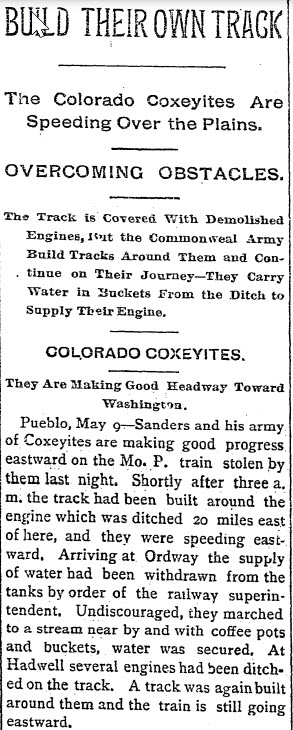This guest post was written by Jim England – lawyer, historian, and Colorado Historic Newspapers Collection top journeymen editor (correcting 521,614 lines of text!). A Colorado resident since 1979, England’s first foray into local history was writing a history for his Boulder law firm’s Centennial as well as writing a history for the Boulder County Bar Association’s Centennial which led to further general Boulder County historical research. England has served as former Board president of the Museum of Boulder and current copy-editing/fact-checking volunteer for History Colorado.
Several months ago, I was doing some routine Colorado Historic Newspapers Collection (CHNC) text correction, focusing as I usually do on local articles in 19th Century Boulder newspapers. My attention was arrested by a non-local item in the May 9, 1894 Boulder Daily Camera, reporting from Pueblo on a bunch of “Coxeyites” having stolen a train and being forced to haul water to it from a stream in coffee pots. What? I had vaguely heard of a labor movement at that time known as “Coxey’s Army,” but had never heard of a Colorado train theft and of such hand-carried water.

Intrigued by such an unusual story, I started searching for accounts appearing in non-Boulder CHNC newspapers, and soon discovered that the stolen-train escapade was extensively covered over the course of an entire month in a variety of newspapers, particularly the Pueblo’s Colorado Daily Chieftain. And this led in turn to the discovery that the story had pretty much dropped out of sight after 1894, with only sporadic mentions of it in print over the next 120+ years.
I then proposed to the head of publications for History Colorado, Sam Bock, that the story deserved to be re-told. He agreed, and we collaborated on an article about the stolen train, and a contemporaneous ill-fated attempt by Coxeyites in Denver to travel down the flood-swollen Platte River in homemade rafts. That article, By Rail and River, appears in the current issue of Colorado Magazine, when the digital version was released several months ago, Sam told me that many people came up to him saying, “I’ve never heard of that story before.”
My experience illustrates two uniquely invaluable aspects of the CHNC: permitting the discovery (even if fortuitous) of unknown or forgotten episodes of Colorado history, and enabling those episodes to be researched and exposed. In my case here, without the CHNC, it would have been flatly impossible for me to have learned of the stolen-train story in the first place, and completely impossible to have researched it enough to put together a written account of it.
Quite frankly, the serendipitous discovery of the arcane events and personages of the past is one of the most rewarding aspects of CHNC text correction for me. I used to think that I had a pretty solid understanding of local Boulder history, but I cannot calculate the number of new discoveries I have made, completely unexpectedly, from routine text correction. For example, I recently ran across an account of a Fourth of July celebration near Boulder in 1864, that turned out to provide previously-unknown information about the soldiers in the local fort there who were just weeks away from the Sand Creek Massacre. Without CHNC, that information would have stayed unknown.
I also cannot calculate the number of times I have contacted, or been contacted by, other researchers, either in Colorado or from out-of-state, who were not aware of the CHNC resource. In each instance, they were amazed and appreciative when I led them to the CHNC site, and were thereby able to obtain the local historical source material they otherwise would have never found.
Occasionally, I consult other states’ similar, usually free, newspaper collections, or the definitely not-free national-newspaper collections. Each time, I come away with a new appreciation for CHNC’s depth and ease-of-use.
Before I retired as a trial lawyer, I would sometimes be asked to assess whether another attorney’s handling of a case met the applicable professional standard. Now as a self-taught historical researcher, I am confident in saying that anyone researching Colorado history would commit professional malpractice by failing to utilize this essential resource.
______________________________________________________________________________________________________
The searchable text in the CHNC has been automatically generated using Optical Character Recognition (OCR) software. OCR, is a process by which software reads an image of text and transcribes it into a text file by recognizing the shapes of the letters. OCR enables searching of large quantities of full-text data, but it is never 100% accurate. The level of accuracy depends on the print quality of the original issue, its condition at the time of microfilming, the level of detail captured by the microfilm scanner, and the quality of the OCR software.
OCR text correction allows members of the public to help improve the searchability of this collection by correcting errors in the text of the digitized newspapers. Saving these corrections to the collection database improves the accuracy of the text, which enables better search results and a richer experience for all users. Since 2015, 1,217 CHNC text correctors have corrected 9,663,417 lines of text. Read here to learn tips and tricks for correcting text in CHNC. We appreciate all of the hard work!
- 2025 Support for Newspaper Digitization - November 13, 2024
- An Appreciation of the Colorado Historic Newspapers Collection - November 4, 2024
- “Journalism is the first rough draft of history” – Philip L. Graham - October 23, 2024